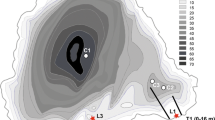Abstract
Diatoms and other microfossils are used extensively in reconstructions of past climates and environments, in both terrestrial and marine settings. Both relative and absolute abundances of diatom taxa in sediment are important tools in these reconstructions. However, acquiring these data is a labor-intensive process. Settling-based diatom slide preparation techniques often bias samples through aliquot subsampling and sediment washing. Other techniques involve the use of added markers, which might obscure diatoms on the slide. This paper presents a revision to the widely adopted settling-based diatom slide preparation method presented by Scherer (J Paleolimnol 12:171–179, 1994) and provides a direct comparison to another widely used method. Evenly distributed diatom slides can be created by a settling process, which yields multiple statistically similar diatom slides without needing to clean sediment of salts or do aqueous subsampling, which may impart a bias in the sample when there is a wide range of particle shapes and sizes in the assemblage. Two samples originally utilized by Scherer (J Paleolimnol 12:171–179, 1994) were prepared via the updated method through a series of replicates. These results were compared to the same samples, processed with the method of Schrader and Gersonde (Utrecht Micropaleontol Bull 17:129–176, 1978), utilizing Petri dishes and the original results of Scherer (J Paleolimnol 12:171–179, 1994). The new modification presented here produces smaller standard deviations than the original Scherer method, and order of magnitude better statistics than the Schrader and Gersonde (Utrecht Micropaleontol Bull 17:129–176, 1978) method.


Similar content being viewed by others
References
Armand L, Crosta X, Romero O, Pichon J-J (2005) The biogeography of major diatom taxa in Southern Ocean sediments: 1. Sea-ice related species. Palaeogeogr Palaeoclimatol Palaeoecol 223:93–126
Barbara L, Crosta X, Massé G, Ther O (2010) Deglacial environments in eastern Prydz Bay, East Antarctica. Quat Sci Rev 29:2731–2740
Battarbee R (1973) A new method for the estimation of absolute microfossil numbers, with reference especially to diatoms. Limnol Oceanogr 18:647–653
Battarbee R (1986) Diatom analysis. In: Berglund B (ed) Handbook of Holocene palaeoecology and palaeohydrology. Wiley, New York, pp 527–569
Battarbee R, Jones V, Flower R, Cameron N, Bennion H, Carvalho L, Juggins S (2001) Diatoms. In: Smol J, Birks J, Last W, Bradley R, Alverson K (eds) Tracking environmental change using lake sediments, vol 3., Terrestrial, algal, and siliceous indicatorsSpringer, Netherlands, pp 155–202
Bennion H, Juggins S, Anderson N (1996) Predicting epilimnetic phosphorus concentrations using and improved diatom-based transfer function and its application to lake eutrophication management. Environ Sci Technol 30:2004–2007
Birks H, Line J, Juggins S, Stevenson A, Terbraak C (1990) Diatoms and pH reconstruction. Philos Trans R Soc Lond B Biol Sci 327:263–278
Cortese G, Gersonde R (2007) Morphometric variability in the diatom Fragilariopsis kerguelensis: implications for Southern Ocean paleoceaongraphy. Earth Planet Sci Lett 257:526–544
Crosta X (2009) Holocene size variations in two diatom species off East Antarctica: productivity vs. environmental conditions. Deep Sea Res Part I Oceanogr Res Pap 56:1983–1993
Fritz S, Juggins S, Battarbee R, Engstrom D (1991) Reconstruction of past changes in salinity and climate using a diatom-based transfer function. Nature 352:706–708
Kingston J, Birks H (1990) Dissolved organic carbon reconstructions from diatom assemblages in PIRLA project lakes, North America. Philos Trans R Soc Lond B Biol Sci 327:279–288
Konfirst M, Kuhn G, Monien D, Scherer R (2011) Correlation of early Pliocene diatomite to low amplitude Milankovitch cycles in the ANDRILL AND-1B core. Mar Micropaleontol 80:114–124
Leventer A (1998) The fate of Antarctic “sea-ice diatoms” and their use as paleoenvironmental indicators. Antarct Sea Ice Biol Process Interact Var Antarct Res Ser 73:121–137
Romero O, Swann G, Hodell D, Helmke P, Rey D, Rubio B (2011) A highly productive Subarctic Atlantic during the Last Interglacial and the role of diatoms. Geology 39(11):1015–1018
Scherer R (1994) A new method for the determination of absolute abundance of diatoms and other silt-sized sedimentary particles. J Paleolimnol 12:171–179
Schrader H-J, Gersonde R (1978) Diatoms and silicoflagellates. Utrecht Micropaleontol Bull 17:129–176
Snoeijs P, Busse S, Potapova M (2002) The importance of diatom cell size in community analysis. J Phycol 38:265–272
Zar HJ (2010) Biostatistical analysis, 5th edn. Pearson Education, Upper Saddle River 944 pp
Acknowledgments
This research was supported by US National Science Foundation (NSF) Grant ANT-1043690. JW thanks Leanne Armand for the opportunity to gain experience with the Schrader and Gersonde method, during his time visiting her lab as part of his NSF East Asia and Pacific Summer Institutes Grant. Thanks to our reviewers for thoughtful and through reviews. The authors offer material used in this study in order to perform a cross-calibration.
Author information
Authors and Affiliations
Corresponding author
Rights and permissions
About this article
Cite this article
Warnock, J.P., Scherer, R.P. A revised method for determining the absolute abundance of diatoms. J Paleolimnol 53, 157–163 (2015). https://doi.org/10.1007/s10933-014-9808-0
Received:
Accepted:
Published:
Issue Date:
DOI: https://doi.org/10.1007/s10933-014-9808-0



